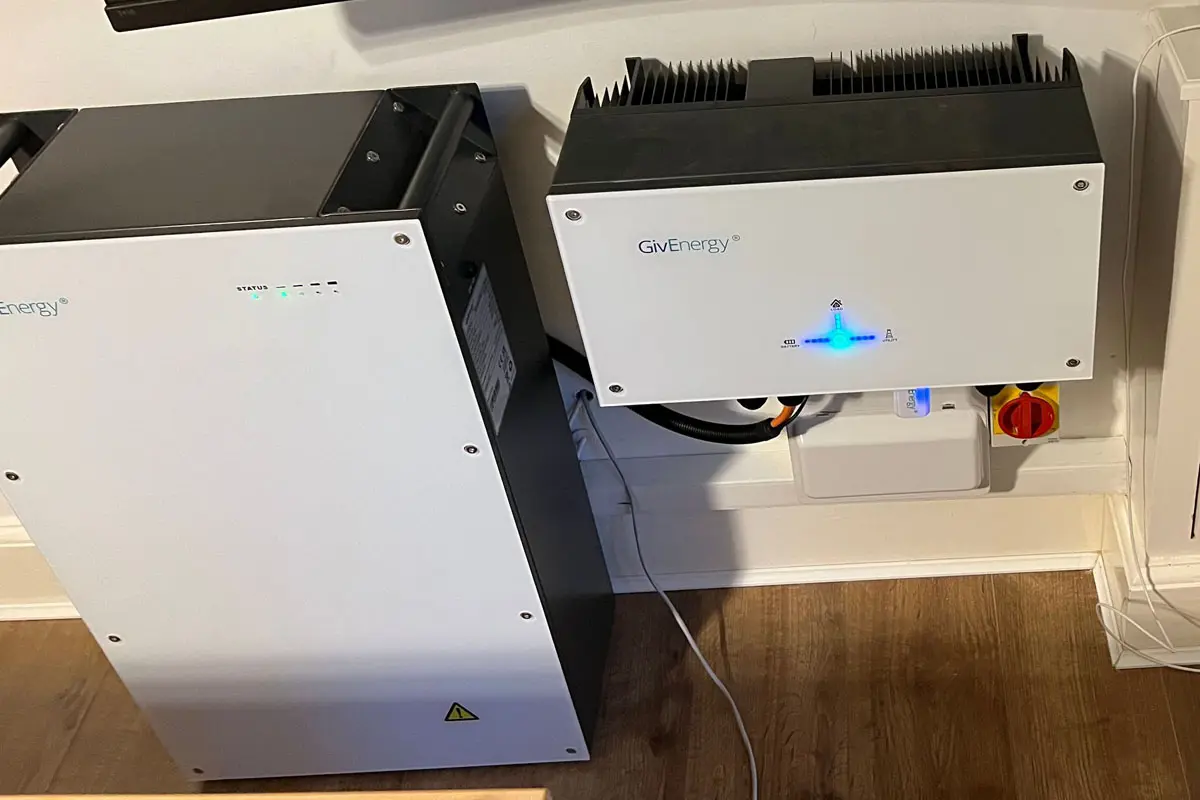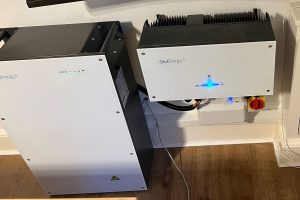Best Home Battery Storage Systems
Each year customers come to us at Tanjent and ask, “What are the best solar batteries currently available?”. This is a very good question. We can certainly understand the need to know the differences between solar batteries, as it is a choice that home battery buyers are going to live with for a long time.
See also The Benefits of a Home Battery Storage System and Do Home Battery Systems Work Automatically?
At Tanjent, we sell a range of solar battery systems, and not all of them will be right for you. This article is going to explain the pros and cons of each type of battery system in an honest and transparent manner. This way, by the end, you’ll be able to identify which is the best solar batteries for you.
In this article we’ll specifically cover standalone battery systems of the sort you could use in a new solar array or equally retrofit to an existing solar array, i.e. not the sort of hybrid solar and battery systems that you might choose for a completely new install. On that topic, see also our article on Are Two Inverters Better Than One? Note, also, that you could install one of these systems even if you don’t have solar if you have access to a good time-of-use tariff. Then you charge it cheaply, typically overnight, and use it to power your house during the day at a reduced rate.
The five battery systems we are going to cover are the Solis RAI, the GivEnergy AC3, the GivEnergy All-in-one, the Victron Quattro and the Tesla Powerwall. They are listed in no particular order as they cover a wide range of prices and features.
Prices quoted below do not include optional power cut backup (there are additional charges for that, including rewiring and the supply and installation of a dedicated earth rod).
[They also do not include VAT as this is 20% for a retrofit, but 0% if installed at the same time as a solar inverter.] Update February 2024: The Government has changed the VAT rules so an installed battery is now always 0% VAT.
1. Solis RAI
Specification:
- Full name: Solis RAI AC 5G (RAI-3K-48ES-5G)
- Description: A battery inverter made by Solis which is typically combined with solar batteries made by Pylontech
- Inverter power: 3kW
- Battery capacity: Can use multiples of Pylontech 3.5kWh and 4.8kWh batteries
- Price: £4260+VAT installed with a Pylontech US5000 (4.8kWh) battery*
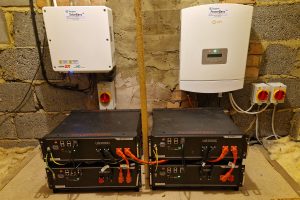
Solis RAI AC battery inverter on the right, with batteries below and SolarEdge solar inverter on the left (Image: Tanjent)
Pros: This is our go-to battery inverter for smaller systems as it is low cost and very flexible – you can choose a range of battery sizes to go with it. You can also add more batteries to it later easily (even plugging them in yourself if you are DIY minded). The inverter is quite small so there’s usually somewhere it can fit, and the wiring and general installation are very straightforward. Being low cost, it can pay for itself quite quickly – if you’re looking for good payback then a low cost system is the best place to start.
Cons: The inverter is limited to 3kW power which may not be enough for many homes, particulary for power cut backup. The online interface is serviceable but not fully featured, and we have seen feedback about the smartphone app being a bit buggy. While it allows cheap time of use charging (e.g. overnight charging on an Economy 7 or Octopus Go tariff) this is configured by specifying a duration and a power to charge (e.g. 2kW for 2 hours) rather than the more friendly charge target (e.g. 60% full) that other systems use.
2. GivEnergy AC3
Specification:
- Full name: GivEnergy AC3 AC Coupled
- Description: A battery inverter and separate batteries made by GivEnergy
- Inverter power: 3kW
- Battery capacity: Can use multiples of GivEnergy 2.6kWh, 5.2kWh, 8.2kWh or 9.5kWh batteries
- Price: £4950+VAT installed with a 5.2kWh battery*
Pros: This is a popular choice for mid-size systems as it has a good cost per kWh, and it offers a large range of battery sizes. Unlike the Solis, you can set a straightforward target charge level you want to achieve during overnight charging (e.g. 60% in the winter to allow 40% spare to top up with solar).
Cons: It is not user-expandable (an electrician visit is required to add another battery). The online interface is serviceable but not very user friendly. We have seen some difficulties with getting these systems commissioned at installation, and sometimes they need subsequent GivEnergy support to get them working optimally. Customers have waited some time for promised software features and fixes to get rolled out.
3. GivEnergy All in One
Specification:
- Full name: GivEnergy All in One AC Coupled
- Description: An integrated battery inverter and batteries in a box, with a separate Gateway (interface) box
- Inverter power: 6kW (7.2kW peak)
- Battery capacity: 13.5kWh
- Price: £9520+VAT installed*
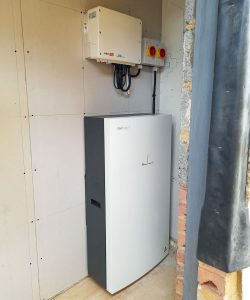
A GivEnergy All in One (installed as part of a property refurbishment), with solar inverter above (Image: Tanjent)
Pros: This is our go-to battery system for larger installs as it has a low cost per kWh, and can provide power cut backup ‘out of the box’. We have covered it in detail in a previous article: GivEnergy All in One Home Battery System Review and Specs.
Cons: Some documentation implies that the Gateway boxes are optional, but they are actually required currently for all UK installs. Otherwise the Cons are very similar to that of the AC3.
4. Victron Quattro
Specification:
- Full name: Victron Quattro 48/5000/70, 48/8000/110 and 48/10000/140 models
- Description: An inverter charger made by Victron which is typically combined with batteries made by Pylontech
- Inverter power: available in 5000VA (4.5kW), 8000VA (7kW) and 10000VA (9kW) models
- Battery capacity: Can use multiples of Pylontech 3.5kWh batteries
- Price: from £7700+VAT for a Quattro 8000 installed with 2 Pylontech US3000 batteries (total 7.1kWh)*
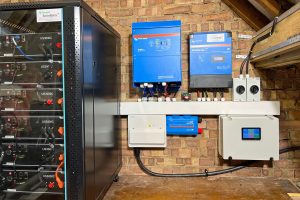
A large off-grid battery system with Victron Quattro 8000 centre, a Victron solar charge controller right, and 6 Pylontech US3000 batteries left (Image: Tanjent)
Pros: This is our go-to battery inverter for off-grid backup as it is very powerful and configurable. Your mains supply gets rerouted through the inverter, and it gets to control whether your house is being powered by the grid or the batteries – this means that it can swap over in a few milliseconds so your computers and clocks don’t even notice when you get a power cut. Like the Solis, you can choose a range of battery sizes to go with it and you can add more batteries to it later easily yourself.
Cons: A full Victron install contains many sub-components (screens, controllers, cables, meters, etc.) so it can be quite expensive, and requires an experienced installer to wire and configure it correctly.
4. Tesla Powerwall
Specification:
- Full name: Tesla Powerwall 2
- Description: An integrated battery inverter and batteries in a box, with a separate Gateway (interface) box
- Inverter power: 5kW (7kW peak)
- Battery capacity: 13.5kWh
- Price: We don’t install the Powerwall ourselves, though may do from next year. Market prices are typically from £8000 installed.
Pros: The original Powerwall was arguably the battery system that did the most to promote the idea of home batteries. Although there now are many competitors, the latest version of the Powerwall provides a good balance of power and capacity at a reasonable price.
Cons: It’s big and heavy. We have seen some customer feedback that the ‘cleverness’ of the Powerwall can be frustrating, as it can be automatically charging and discharging at times that the user doesn’t expect.
Summary
That’s a quick overview of the top 5 standalone battery systems. If you want to know which one is right for you, and to get a custom proposal, just contact us.
* prices as at November 2023.



